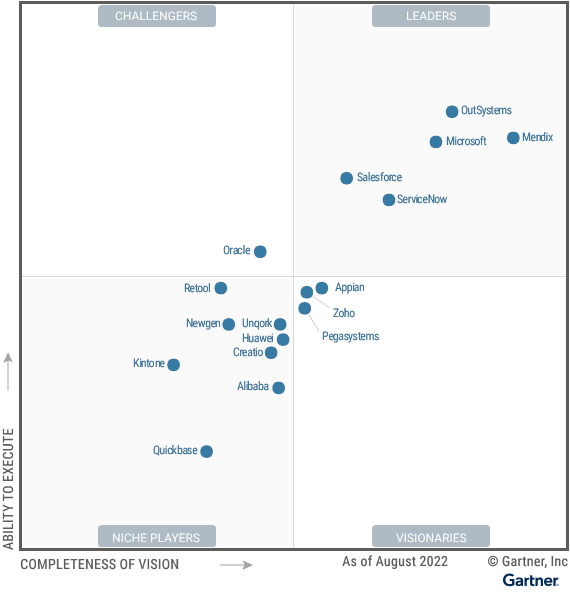In the ever-evolving landscape of technology, businesses are constantly pursuing paths to simplify their operations, enhance productivity, and achieve rapid digital transformation. In recent years, Enterprise Low Code Application Platforms (LCAPs) popularly known as Low Code/No Code development platforms have emerged as revolutionary solutions, empowering organizations to create custom applications without the need for extensive coding expertise. Among these platforms, Gartner’s 2023 Magic Quadrant for Enterprise LCAPs, recognizes Microsoft’s Power Platform as a leader, driving innovation and fostering a new era of business automation. In this post, we will explore the industry trends, benefits, considerations, future adoption of Low Code and No Code products, and a highlight on Power Platform unique offerings.

Industry Trends
The rise of Low Code and No Code platforms has been meteoric, with businesses across diverse sectors embracing their potential. This trend has been fueled by the ever-increasing demand for agility, flexibility, and reduced time-to-market. As traditional development approaches often encounter resource constraints and time-intensive processes, Low Code and No Code solutions have enabled organizations to expedite application development and maintenance. Moreover, with these platforms, businesses can leverage the skills of citizen developers – employees without formal coding backgrounds – to actively participate in application creation, thereby democratizing the development process.
But what does the data say?

Low Code and No Code Benefits
- Accelerated Application Development: Low Code and No Code platforms offer a wide array of pre-built components, templates, and drag-and-drop features, significantly reducing the time and effort required to develop applications. This empowers businesses to respond swiftly to changing landscape and stay ahead of the competition.
- Enhanced Efficiency and Productivity: With the ability to automate repetitious tasks and simplify workflows, these platforms improve overall operational efficiency, freeing up valuable human resources to focus on higher-value initiatives.
- Cost-Effectiveness: By minimizing the need for professional developers and simplifying the development process, Low-Code and No-Code platforms reduce development costs, making them an attractive option for businesses of all sizes.
- Empowering Citizen Developers: Citizen developers, possessing domain-specific knowledge, can actively contribute to application development, promoting a culture of innovation and partnership within the organization.
- Seamless Integration: Power Platform and similar products offer seamless integration with various existing systems, databases, and cloud services, ensuring a cohesive ecosystem that enhances data accessibility and decision-making.
The proof is in the pudding – our team recently helped a global market leader in material handling systems implement Power Platform. The results? A 35% direct cost savings and 50% increase in team productivity! Not to mention heightened end-user sustainability via empowering internal SMEs.
Considerations
While Low Code and No Code platforms offer numerous advantages, there are some considerations that businesses should keep in mind:
- Complexity of Applications: While these platforms excel at creating simple and medium-complexity applications, they may face limitations when handling highly complex, custom requirements.
- Security and Compliance: As citizen developers gain more control over application development, organizations must implement resilient security standards and ensure compliance with data privacy regulations.
- Maintaining Quality: Despite the ease of development, it’s crucial to maintain rigorous testing and quality assurance practices to ensure the reliability and functionality of the applications.
Future Adoption Trends
The future of Low Code and No Code platforms, including Power Platform, appears exceedingly promising. As these offerings continue to evolve, we can foresee several key trends:
- Expansion of Use Cases: Low Code and No Code products are likely to find applications across diverse industries, ranging from finance and healthcare to education and government, addressing a broad spectrum of business needs.
- AI Integration: The integration of Artificial Intelligence (AI) capabilities will further enhance the functionality of these platforms, enabling businesses to build intelligent applications that can automate decision-making processes and analyze data more effectively. With the recent introduction of Copilot in Microsoft Power Apps, creators can now create apps via a conversation using the AI-powered toolset.
- Hybrid Development: The future will see a blend of Low Code/No Code and traditional development approaches, enabling developers to combine the best aspects of both worlds to create more robust and customized solutions.
- Increased Focus on Governance: To ensure security, compliance, and maintain quality, organizations will place a greater emphasis on governance models, overseeing application development and deployment within the organization.
Low Code and No Code platforms like Microsoft Power Platform have revolutionized application development, democratizing the process and empowering businesses to drive digital transformation. With benefits ranging from faster growth and enhanced efficiency to cost-effectiveness and citizen developer empowerment, the adoption of these platforms is set to accelerate in the coming years. Organizations must carefully consider the potential and limitations of such solutions while also staying ahead of future trends to make the most of this transformative technology. Embracing Low Code and No Code platforms is not only a strategic move for businesses but a step toward a more agile, innovative, and profitable future.

Josh Petla, Cloud Practice Leader

